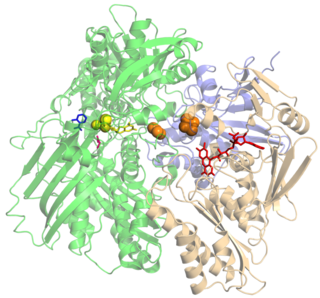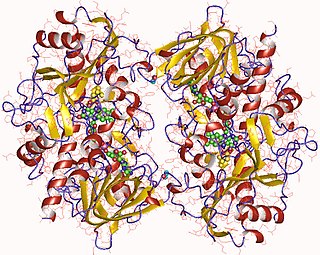Related Research Articles

Oxidative phosphorylation or electron transport-linked phosphorylation or terminal oxidation is the metabolic pathway in which cells use enzymes to oxidize nutrients, thereby releasing chemical energy in order to produce adenosine triphosphate (ATP). In eukaryotes, this takes place inside mitochondria. Almost all aerobic organisms carry out oxidative phosphorylation. This pathway is so pervasive because it releases more energy than alternative fermentation processes such as anaerobic glycolysis.
A dehydrogenase is an enzyme belonging to the group of oxidoreductases that oxidizes a substrate by reducing an electron acceptor, usually NAD+/NADP+ or a flavin coenzyme such as FAD or FMN. Like all catalysts, they catalyze reverse as well as forward reactions, and in some cases this has physiological significance: for example, alcohol dehydrogenase catalyzes the oxidation of ethanol to acetaldehyde in animals, but in yeast it catalyzes the production of ethanol from acetaldehyde.

Xanthine oxidase is a form of xanthine oxidoreductase, a type of enzyme that generates reactive oxygen species. These enzymes catalyze the oxidation of hypoxanthine to xanthine and can further catalyze the oxidation of xanthine to uric acid. These enzymes play an important role in the catabolism of purines in some species, including humans.

Flavoproteins are proteins that contain a nucleic acid derivative of riboflavin. These proteins are involved in a wide array of biological processes, including removal of radicals contributing to oxidative stress, photosynthesis, and DNA repair. The flavoproteins are some of the most-studied families of enzymes.
Any enzyme system that includes cytochrome P450 protein or domain can be called a P450-containing system.
In enzymology, a columbamine oxidase (EC 1.21.3.2) is an enzyme that catalyzes the chemical reaction
In enzymology, a reticuline oxidase (EC 1.21.3.3) is an enzyme that catalyzes the chemical reaction
In enzymology, a (S)-canadine synthase (EC 1.14.21.5) is an enzyme that catalyzes the chemical reaction

In enzymology, a choline oxidase (EC 1.1.3.17) is an enzyme that catalyzes the chemical reaction
In enzymology, a linoleate diol synthase (EC 1.13.11.44) is an enzyme that catalyzes the chemical reaction

Olivetol, also known as 5-pentylresorcinol or 5-pentyl-1,3-benzenediol, is an organic compound found in certain species of lichen; it is also a precursor in various syntheses of tetrahydrocannabinol.

Glycine oxidase (EC 1.4.3.19) is an enzyme with systematic name glycine:oxygen oxidoreductase (deaminating). This enzyme catalyses the following chemical reaction
o-Aminophenol oxidase (EC 1.10.3.4, isophenoxazine synthase, o-aminophenol:O2 oxidoreductase, 2-aminophenol:O2 oxidoreductase, GriF) is an enzyme with systematic name 2-aminophenol:oxygen oxidoreductase. This enzyme catalyses the following chemical reaction
Linoleate 8R-lipoxygenase (EC 1.13.11.60, linoleic acid 8R-dioxygenase, 5,8-LDS (bifunctional enzyme), 7,8-LDS (bifunctional enzyme), 5,8-linoleate diol synthase (bifunctional enzyme), 7,8-linoleate diol synthase (bifunctional enzyme), PpoA) is an enzyme with systematic name linoleate:oxygen (8R)-oxidoreductase. This enzyme catalyses the following chemical reaction
1,8-Cineole 2-endo-monooxygenase (EC 1.14.14.133, Formerly EC 1.14.13.156, P450cin, CYP176A, CYP176A1) is an enzyme with systematic name 1,8-cineole,NADPH:oxygen oxidoreductase (2-endo-hydroxylating). This enzyme catalyses the following chemical reaction

Tetrahydrocannabinolic acid (THCA) synthase is an enzyme responsible for catalyzing the formation of THCA from cannabigerolic acid (CBGA). THCA is the direct precursor of tetrahydrocannabinol (THC), the principal psychoactive component of cannabis, which is produced from various strains of Cannabis sativa. Therefore, THCA synthase is considered to be a key enzyme controlling cannabis psychoactivity. Polymorphisms of THCA synthase result in varying levels of THC in Cannabis plants, resulting in "drug-type" and "fiber-type" C. sativa varieties.
3,5,7-Trioxododecanoyl-CoA synthase (EC 2.3.1.206, TKS) is an enzyme with systematic name malonyl-CoA:hexanoyl-CoA malonyltransferase (3,5,7-trioxododecanoyl-CoA-forming). This enzyme catalyses the following chemical reaction
Geranyl-pyrophosphate—olivetolic acid geranyltransferase is an enzyme with systematic name geranyl-diphosphate:olivetolate geranyltransferase. This enzyme catalyses the following chemical reaction

Berberine bridge enzyme-like form a subgroup of the superfamily of FAD-linked oxidases, structurally characterized by a typical fold observed initially for vanillyl-alcohol oxidase (VAO). This proteins are part of a multigene family (PF08031) that can be found in plants, fungi and bacteria.

Cannabichromenic acid (CBCA) is minor cannabinoid and precursor of cannabichromene.
References
- 1 2 3 Taura F, Morimoto S, Shoyama Y (July 1996). "Purification and characterization of cannabidiolic-acid synthase from Cannabis sativa L.. Biochemical analysis of a novel enzyme that catalyzes the oxidocyclization of cannabigerolic acid to cannabidiolic acid". The Journal of Biological Chemistry. 271 (29): 17411–6. doi: 10.1074/jbc.271.29.17411 . PMID 8663284.
- 1 2 3 4 5 Taura F, Sirikantaramas S, Shoyama Y, Yoshikai K, Shoyama Y, Morimoto S (June 2007). "Cannabidiolic-acid synthase, the chemotype-determining enzyme in the fiber-type Cannabis sativa". FEBS Letters. 581 (16): 2929–34. doi: 10.1016/j.febslet.2007.05.043 . PMID 17544411.
- ↑ Kutchan TM, Dittrich H (October 1995). "Characterization and mechanism of the berberine bridge enzyme, a covalently flavinylated oxidase of benzophenanthridine alkaloid biosynthesis in plants". The Journal of Biological Chemistry. 270 (41): 24475–81. doi: 10.1074/jbc.270.41.24475 . PMID 7592663.
- ↑ Carter CJ, Thornburg RW (January 2004). "Tobacco nectarin V is a flavin-containing berberine bridge enzyme-like protein with glucose oxidase activity". Plant Physiology. 134 (1): 460–9. doi:10.1104/pp.103.027482. PMC 316325 . PMID 14730073.
- ↑ "CBDAS - Cannabidiolic acid synthase precursor - Cannabis sativa (Hemp) - CBDAS gene & protein". UniProt. Retrieved 26 February 2016.